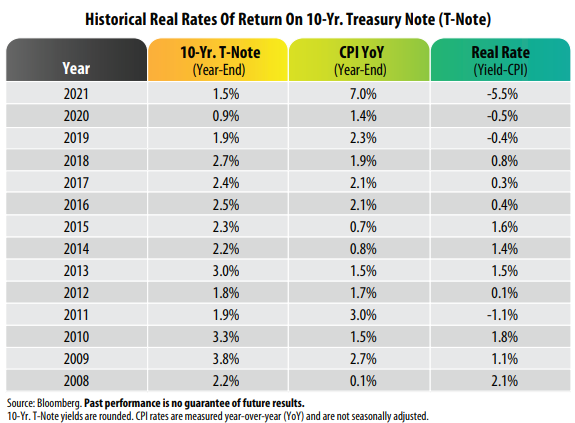
View from the Observation Deck
1. The real rate of return on a bond is calculated by subtracting the most recent inflation rate, such as the Consumer Price Index (CPI), from the bond's current
yield. The higher the real rate the better.
2. As of the close on 12/31/21, the yield on the benchmark 10-year T-note was 1.51% (1.5% rounded), well below the 7.0% trailing 12-month rate on the CPI in
December 2021. That equates to a real rate of -5.5%, which is not attractive.
3. At a base level, in order to maintain one's purchasing power, bond investors have sought to generate a yield that at least outpaces the rate of inflation.
4. For comparative purposes, from 12/31/91 through 12/31/21 (30 years), the average yield on the 10-year T-note was 4.03% (4.0% rounded), while the average
rate on the CPI stood at 2.3% over the same period, according to Bloomberg. Those figures translate into an average real rate of return of 1.7%, far more
attractive than currently available. These would be considered normalized yields/rates, in our opinion.
5. Federal Reserve (“Fed”) Chairman Jerome Powell has changed his expectations on inflation from characterizing it as transitory to it being more persistent in
nature.
6. The Fed announced recently it will reduce its purchases of Treasuries and mortgage-backed securities by $30 billion per month. At that pace, it should be done
buying bonds in the open market by the end of March 2022. It also foresees hiking short-term interest rates three times in 2022. The federal funds target rate
(upper bound) is currently at 0.25%. Its 30-year average is 2.52% (2.5% rounded).
7. Can the Fed do enough in the months ahead to help curb inflation or will it be forced to chase it? Stay tuned!



